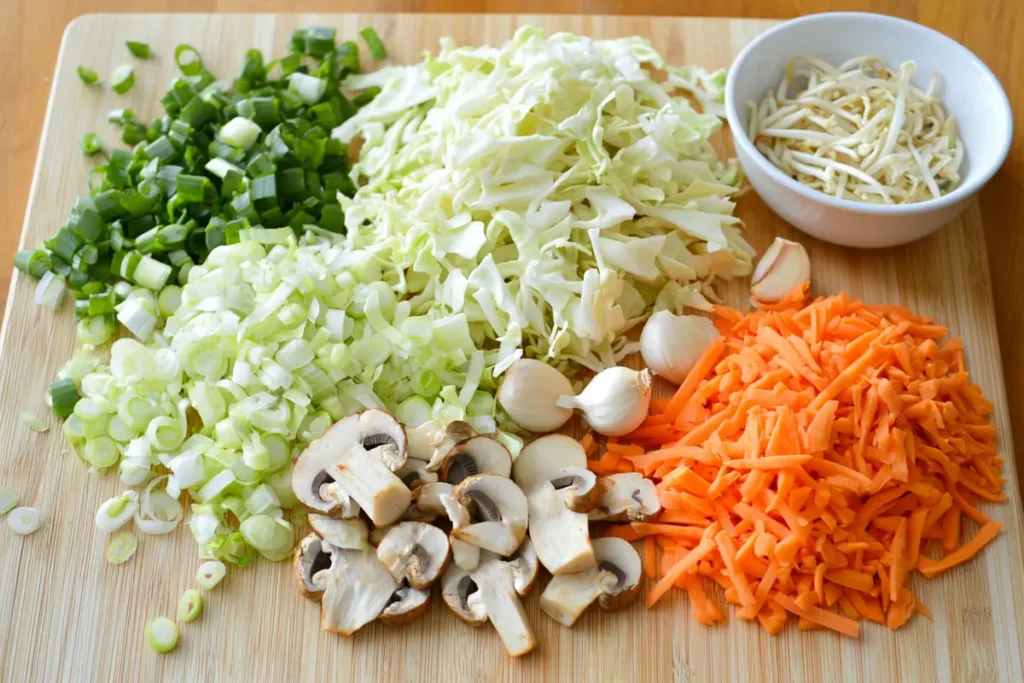Tips and Troubleshooting
Common Mistakes to Avoid
Overstuffing Wrappers
Adding too much filling can cause the wrappers to tear or the rolls to burst open during cooking. Use 2–3 tablespoons of filling per roll and pack it tightly to maintain the structure.
Oil Temperature Issues
Cooking at the wrong temperature can ruin the texture. If the oil is too hot, the rolls will burn on the outside before cooking through. Too cold, and the rolls will absorb excess oil, becoming greasy. Use a thermometer to keep the oil consistently at 350°F (175°C).
Skipping the Cooling Step for Filling
Filling the wrappers with hot vegetables can make them soggy and difficult to seal. Allow the cooked filling to cool completely before assembling the rolls.
Storing and Reheating Leftovers
Veggie egg rolls taste best fresh, but leftovers can be just as delicious if stored and reheated properly.
Maintaining Crispiness
- Store leftover rolls in an airtight container lined with paper towels to absorb excess moisture.
- To reheat, use an oven or air fryer instead of a microwave, which can make the wrappers soggy.
Safe Storage Practices
- Refrigerate cooked egg rolls within 2 hours to prevent spoilage.
- For longer storage, freeze uncooked egg rolls in a single layer on a baking sheet before transferring them to a freezer-safe bag. Cook them directly from frozen for the best texture.
Frequently Asked Questions
What kind of vegetables do you put in egg rolls?
Veggie egg rolls are highly versatile, allowing you to use a variety of vegetables based on your taste preferences. Common choices include shredded cabbage, carrots, and bean sprouts, which provide a satisfying crunch. Green onions add a mild sharpness, while mushrooms like shiitake or button mushrooms bring an earthy flavor. Bell peppers, zucchini, or even broccoli can be incorporated for a burst of color and texture. The key is to use finely chopped or shredded vegetables to ensure even cooking and easy wrapping. Feel free to experiment with seasonal produce to create your own unique combinations!
Are vegetable egg rolls healthy for you?
Yes, vegetable egg rolls can be a healthy snack or appetizer when prepared thoughtfully. They are packed with nutrient-rich vegetables like cabbage and carrots, which provide fiber, vitamins, and antioxidants. Opting for baking or air-frying instead of deep-frying significantly reduces calories and fat, making them a lighter choice. Additionally, using whole-grain or gluten-free wrappers can boost their nutritional value. However, like any dish, moderation is key, as excessive sauces or large portions can add extra sodium and calories. Homemade egg rolls allow you to control the ingredients, ensuring a healthier and delicious option.
What is the difference between veg roll and veg spring roll?
The primary difference lies in the wrappers and preparation methods. Veg rolls, often referred to as egg rolls in Chinese-American cuisine, use thicker, wheat-based wrappers that become crispy when fried or baked. The filling typically includes sautéed or stir-fried vegetables. On the other hand, spring rolls use thinner rice paper or pastry-style wrappers, often associated with Vietnamese or Thai cuisine. Spring rolls may be served fresh (uncooked) or fried, with fillings ranging from raw veggies to shrimp. While both are delicious, veg rolls tend to have a heartier, crunchier texture compared to the delicate nature of spring rolls.
Do plant-based egg roll wrappers taste different?
Plant-based egg roll wrappers, which exclude eggs or dairy, have a subtle difference in taste and texture compared to traditional wrappers. They tend to be slightly lighter and less rich in flavor, allowing the filling’s taste to shine through. Most plant-based wrappers are made from wheat or rice flour, making them just as crisp and golden when cooked. When prepared properly, the difference is minimal, and they provide a great option for vegans or those with dietary restrictions. Whether baked, fried, or air-fried, plant-based wrappers deliver a satisfying crunch that complements the flavorful vegetable filling perfectly.






